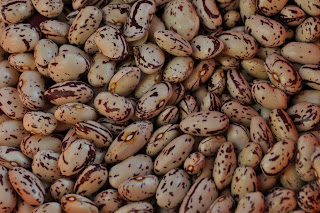"There seems to be but three ways for a nation to acquire wealth. The first is by war, as the Romans did in plundering their conquered neighbours. This is robbery. The second is by commerce, which is generally cheating. The third is by agriculture, the only honest way; wherein man receives a real increase of the seed thrown into the ground in a kind of continual miracle."
-Benjamin Franklin
The 2012 growing season is winding down now, the harvest moon has passed and the fruits, seeds and veggies are being picked, eaten and preserved. This year, one of the major success stories in my humble garden was the beans.
Deciding to really try to maximize the space in my small garden, Pole Beans became an obvious choice. To easily store the harvest for a long time without too much work or energy, dry beans were the best choice. The combination of Pole Dry Beans is not too common, but I did find two lovely varieties.
Pole Beans climb up high, some get to ten feet, and they set pods all along the plant, so one plant produces many beans, without a large foot print in the garden. Once it is time to harvest you either let the pods dry out on the plant, which works really well when it isn't raining, or if it is beginning to rain, pull the whole plants out and hang them upside down under cover until they are dry.
The beans are ready to harvest once the pods are dried out and crisp.
The Cherokee Corn Field bean that I found set many pods along the central stem of the plant, which substantially increased the number of beans it produced. It really amazed me, this bean seed has become one of my more precious possessions, I bought it from
Salt Spring Seeds. The other type of pole dry beans I found was Burlotti Beans, and Italian dry bean that looks to be good in soup, I bought it from
West Coast Seeds.
With 30 Cherokee Corn Field seeds, and 30 Burlotti Bean seeds I was able to produce all of these beans. There was an average of 10 pods per plant, with each pod holding on average 6 beans, so approximatly 60 beans from each plant, each bean with the potential to create one more plant and 60 more beans. I need more land I think. Or maybe I'll save some and make some nice soup with the rest.
I had to do a race of course, I'm hyper competitive. The Burlotti is on the left, the Cherokee Corn Field on the right.
The Burlotti's are about the size of kidney beans, and I like their speckled appearance. I gave them 10ft by 3ft of growing space, and plenty of stakes ( pruned tree branches and actual stakes too.)
They took off the fastest, and were less affected by the slugs who began assaulting the other beans in the wettest June I'd ever seen.
The Cherokee Corn field beans are so varied in appearance, which makes it really fun to husk them and just stare at them once they've been harvested.
They are smallish, about the size of mung beans. I gave them 12ft by 3ft growing space.
They started out slower, and I was really worried because the slugs were really starting to take them down. I began to sprinkle egg shells around their stems and manually removing the slugs as I saw them. Once we were into July they were big enough that the slugs no longer affected them and they did eventually catch up to the Burlotti's in size.
The Cherokee Corn Field: 1.25 Kg from 12ft by 3ft
The Burlotti Beans: 1.25 Kg from 10ft by 3ft
And a winner? Well the Burlotti produced more weight from a smaller space. But I LOVE the beauty of the Cherokee Corn Field, and it produced more beans overall, so more potential plants next year.
I guess, I am the winner. Ha.
I'm actually surprised that there are not more Pole Dry beans for sale in seed catalogues. By far the most popular pole bean in Vancouver is the Scarlet Runner, it is possible to eat it as a dry bean, but I'd say it's favoured form is the immature green pod, which tastes somewhat like cucumber. I hope more people get on board this Dry Pole Bean kick, and hopefully find and share some other amazing seeds from this productive group.



































